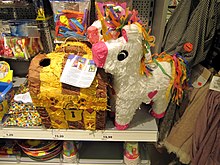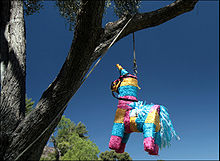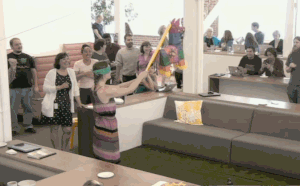Piñata
![]()
This article is about the colorful figures made of papier-mâché. For the film of the same name see Piñata - Demon Island, for the album of the same name by the music group Mexican Institute of Sound see Piñata (album).
![]()
This article or subsequent section is not sufficiently supported by evidence (e.g., anecdotal evidence). Information without sufficient evidence may be removed in the near future. Please help Wikipedia by researching the information and adding good supporting evidence.
Piñatas [piˈɲata] are colorful figures, nowadays made of papier-mâché, formerly made of clay pots wrapped with crepe paper, which are filled with sweets and traditionally with fruits (mandarins, sugar cane, guavas, tejocotes, jicamas, peanuts) at children's birthday parties. They are common in Mexico and Central America at children's birthday parties and at Christmas time, and in Spain at Easter. Piñatas have been offered by retailers on the German market since the 2010s.

Piñatas in a drugstore in Hamburg
Rules
Children, who are blindfolded, take turns hitting the piñata with a stick until it breaks and the surprises hidden inside fall out. The piñata is usually hung on a rope above the children and can only be reached with the stick. Another variation is to attach the piñata so that it can be pulled up and down to make it even more exciting and fun. One child at a time is blindfolded and tries to hit the piñata with the piñata stick, breaking it open. In the meantime, the other children sing the song below. When the song is over, the next child gets to try his or her luck. If the piñata breaks, all the children get to pick up as much as they can catch. For smaller children, there is the pull piñata. These piñatas have several strings on the bottom that the children take turns pulling; only one of the strings opens the compartment from which the toys and candy fall out. To help the child find and hit the piñata, you sing:
| Spanish text Dale, dale, daleNo | Meaningful translation Hit her, hit her, hit herDon't lose |
Besides this version, the following shortened version and several other songs exist:
| Spanish text Dale, dale, daleNo | Meaningful translation Hit her, hit her, hit herDon't lose your aim (literal marksmanship) |

Piñata hanging from a tree in San Diego, USA

A woman smashes a piñata
Meaning
For Central America, the piñata is a symbol of fiestas.
The traditional Christian piñata is a ball with seven cone-shaped points that symbolize the seven deadly sins. In the run-up to Christmas, these stars are often used in Posadas celebrations, symbolizing evil. Once smashed, the falling fruit and candy represent blessings for all participants. The stick used to strike symbolizes the strength God gives one to fight evil, the blindfolded eyes symbolize faith. Today, the piñata has lost its religious symbolism, except at Christmas time, and is used for entertainment.
Modern piñatas are shaped like cartoon characters, treasure chests or unicorns. Some are modelled on the appearance of politicians.

Nine-sided piñata
Search within the encyclopedia